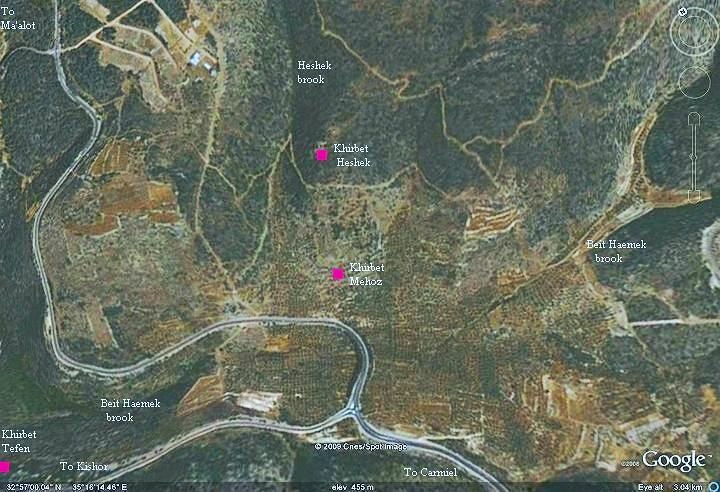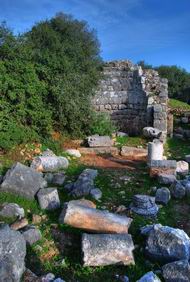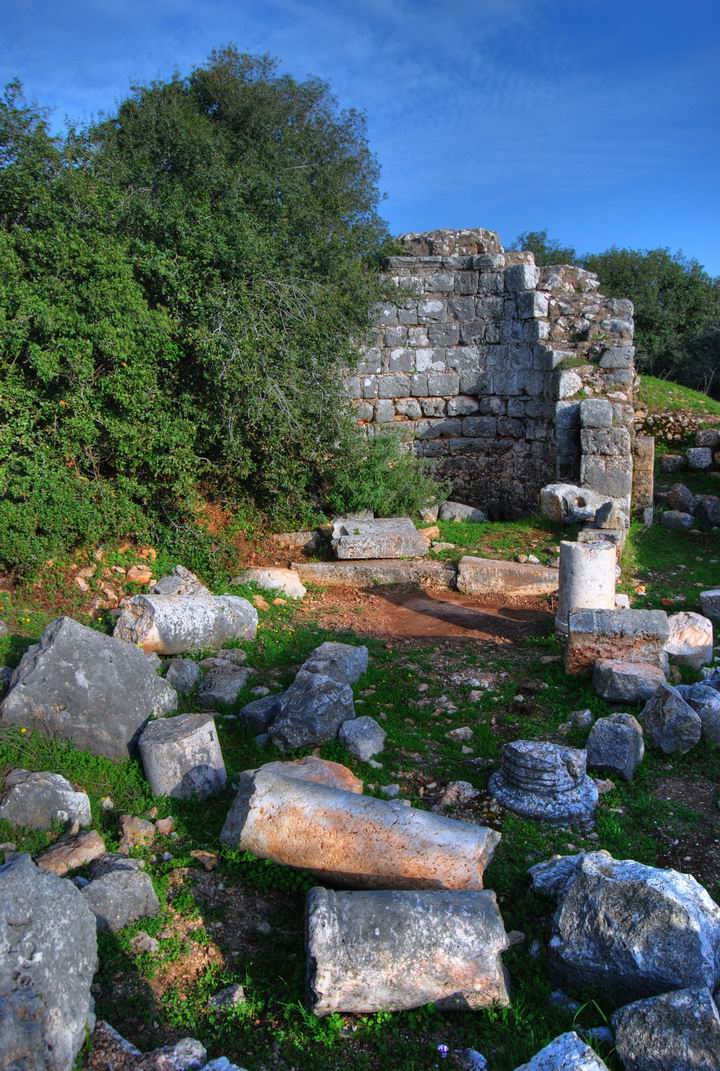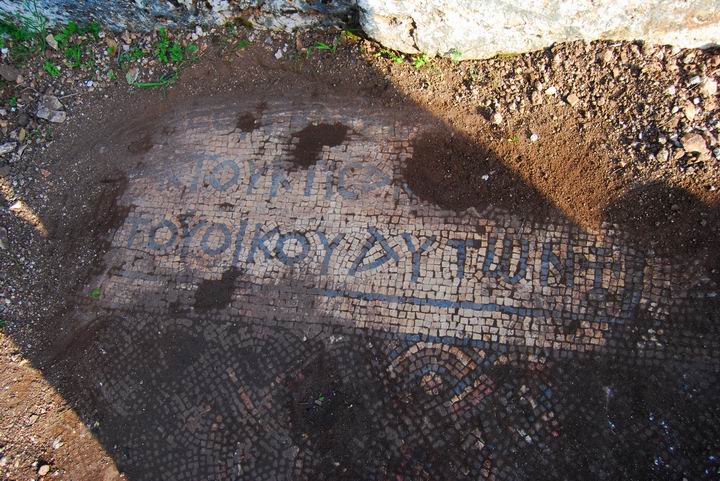Remains of a well preserved 6th century Byzantine church in Tefen area. The structure was probably part of Khirbet Mehoz.
Home > Sites > Upper Galilee > Center > Khirbet Heshek (Hesheq)
Contents:
* Entrance
* Church
Background:
Remains of a secluded Byzantine church on the north bank of the upper Beth-Haemek creek, near Khirbet Mehoz. The ruins are in good condition and mosaic inscriptions were reconstructed and date the structure to the beginning of the 6th century.
Location and Aerial map:
The site of Khirbet Heshek (Kheshek) is located in the area called Tefen, near the brook called Beit Ha-Emek (“house of the valley”). A junction of the modern road (#854) to Ma’alot, Kishor and Carmiel is located nearby. About 200M to the south is another Byzantine site – Khirbet Mehoz. The access to the site is thru Mehoz, by climbing up the hill.

History:
The site was first established in the Byzantine period (4th-7th C AD). It may have been a monastery which operated by the side of the farmers village of Mehoz.
During the Persian and Arab (7th century AD) conquests the site was destroyed. In the Crusaders period the church was rebuilt.
The site was surveyed by the archaeologist Dr. Motti Aviam as part of the archaeological survey of Israel. Webmaster Rotem: Uncle Ronnie also participated in this survey and always praised this site.
Photos
(a) Entrance
On the south side of the ruins, just above Khirbet Mehoz, is an access road that traverses the hill at this point.
Click on the photos to view in higher resolution…
The 2 story structure is seen below, as viewed from the south side. The church is located on the second floor. In front of the church, on its south side, are remains of the balcony.
A closer view of the stones that fell off the gallery above the church.
(b) Church
The church is located on the second level of the structure. The narthex (entry way) is seen below, on the western side of the church. As can be seen, the structure is standing close to the edge of the gorge (named the Heshek brook).
The central apse is seen in the photo below. On the floor are fragments of the columns that originally held the ceiling at a height of 3M. It collapsed after a fire burnt the wooden beams that once held the second floor gallery.
The church had 3 apses which are facing the east – as in all early churches. A closer view of the central apse is seen below.
Another view from the top of the apse is seen below. The large stone in the center of the apse was the base of the main altar’s table.
(d) Mosaics
The floor of the church is covered with mosaics, decorated with geometric patterns in 4 colors. As seen in other early churches, 5th century churches are decorated only with geometric carpets, without figurative objects. The figurative decorations , such as floral, animal and village/hunting scenes, started only in the late 6th century.
A mosaic inscription was found on the floor of the church near the altar. The inscription dedicates the church to Saint George. George was born and lived in the 3rd century AD in the Holy Land city of Lod (Lydda), a city south of Ben-Gurion airport. He was an early Christian, served as a Roman tribune and died in 303. His coffin is located in St. George church (in Lod), where according to a 6th C tradition his remains are located. St. George is regarded as a martyr, a great Holy warrior saint, and is illustrated as a “dragon slayer”. The Lod basilica was dedicated to St George in the Byzantine times, and later other churches were named after the great Martyr.
Another inscription in the floor of the narthex dates the construction of the church to 518 AD.
(d) Findings
On the floor of the church are fragments of the columns that held the ceiling.
Other fragments are seen below.
(d) First floor under the church
The lower floor under the church is built of hewn stones, with several small rooms. An entrance to one of the rooms is seen below.
The interior of the room on the lower floor is seen below.
(e) Nature photos
A turtle is seen below crawling around the area of the church. They are often found crawling on the ground in the Galilee.
Biblical references: The turtle (Hebrew: “Tzav”) is mentioned in the Bible as an attribute of “being covered” since it has a covering shell. A type of wagon was called “turtle” in the Hebrew version in 2 references: Numbers 7 3: “And they brought their offering before the LORD, six covered wagons,…” and Isaiah 66 20: “And they shall bring all your brethren for an offering unto the LORD out of all nations upon horses, and in chariots, and in litters…“. The latter word was not properly translated in the KJV version but in the Hebrew it appears as a sort of covered wagon.
Etymology (behind the name):
-
Khirbet – Ruined site in Arabic;
-
Khurvah (Horvah, Horbah )- Ruined site in Hebrew. Biblical references: Leviticus 26,31: “And I will make your cities waste,…”. Isaiah 44, 26: “…and I will raise up the decayed places thereof.
-
Heshek – Hebrew for desire. The name of the ruins is based on the Arabic name – Kaser El-Ashak – the fortress of desire or lust (the reason for the name is not known, but you should have a desire to go and visit the site).
-
Beit-Haemek: Hebrew: “House of the Valley”. This brook crosses the west upper Galilee, and flows to the Mediterranean sea near Shavey Zion. Biblical reference: the eastern border of the tribe of Asher (Joshua 19 27): “…toward the north side of Bethemek”.
Links:
Nearby sites in BibleWalks:
* Mehoz – a Byzantine village 200 south
* Tefen – a Hellenistic mountain fortress 1200M to the west
BibleWalks.com – Tour the land of the Bible
Khirbet Mehoz<<<–previous site—<<<All Sites>>>—next Upper Galilee site—>>>Khirbet Tefen
This page was last updated on Dec 22, 2008
Sponsored links:


